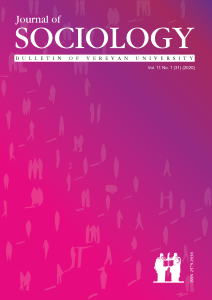The Techniques of Upbringing Symbolism and Their Application in Public Communication
DOI:
https://doi.org/10.46991/BYSU:F/2020.11.1.063Keywords:
upbringing symbolism, visualization of upbringing, techniques of visualization, public communicationAbstract
From a communicative point of view, modern education is a social challenge due to social interaction based on communication influences that go beyond the modern education system. In the context of changes taking place in various modern social processes that affect the formation and development of a personality, the study, identification and application of the new potential of upbringing is of particular importance. The article presents the features of education in the formal and informal educational spheres. The article discusses the methodological basis for studying the upbringing process and considers the problem that the upbringing process takes place not only in the target education system, but also spontaneously, and can be controlled voluntarily and with unpredictable consequences. Based on this, the need to study the technique of visualization of education is revealed, and the question of observing various applications of the visualization of education, especially in the field of public communication, is raised.
References
Cooley, C. H. (1909) Social organization: A study of the larger mind. New York, NY: Charles Scribner's Sons. Doi: https://doi.org/10.1037/14788-000
Craig, R. T. (1999) Communication Theory as a Field. Communication Theory, 9 (2), pp. 119–161. Doi: https://doi.org/10.1111/j.1468-2885.1999.tb00355.x
Richard, L. L. (1992) The Human Science of Communicology, Duquesne University Press.
Isaac, E. C., Deborah Eicher-Catt (2010) Communicology: The New Science of Embodied Discourse. Fairleigh Dickinson Univ Press, 2010.
Adler, A. (1956) The individual psychology: A systematic presentation of selection from his writings. H.L. & R.R. Ansbacher (Eds.). New York: Basic Books.
Bandura, A (1991) Social cognitive theory of self-regulation. Organizational Behavior and Hman Decision Processes, Hillsdate, pp. 248-287. Doi: https://doi.org/10.1016/0749-5978(91)90022-L
Fromm, E. (1955) The sane society. New York: Rinehalt.
Sullivan, H.S. (1953) The interpersonal theory of psychiatry. New York: Norton.
Watson D.L. & Tharp R. G. (1989) Self-directed behavior: Self-modification for personal argument. Pacific Grove, pp. 224–231.
Stolyarenko, A.M. (2006) Obshaya pedagogika, Moscow, YUNITI-DANA, p. 211.
Komenskii, Y.A. (1955) Izbrannye pedagogicheskie sochineniya, Moscow, Gos. uchebno-pedagogicheskoe izdatel'stvo ministerstva prosvescheniya RSFSR.
Rousseau, J.-J. (1979) Emile, or On Education. Trans. Allan Bloom. New York: Basic Books.
Tolstoi, L.N. (1955) Sbornik statei. Posobie dlya uchitelya, Moscow, Gos. uchebno-pedagogicheskoe izdatel'stvo ministerstva prosvescheniya RSFSR, p. 32.
Maslow, A.A. (1943) Theory of Human Motivation. Psychological Review, Vol. 50, No4, pp. 370–396. Doi: https://doi.org/10.1037/h0054346
Rogers, C. & Stevens, B. (1967) Person to Person: The Problem of Being Human. Lafayette, CA: Real People Press. Doi: https://doi.org/10.4324/9780203725672
Rogers, C., Lyon, H. C. & Tausch, R. (2013) On Becoming an Effective Teacher—Person-centered Teaching, Psychology, Philosophy, and Dialogues with Carl R. Rogers and Harold Lyon. London: Routledge.
Fromm, E. (1965) Socialist Humanism, NY: Doubleday.
Fromm, E. (1968) The Revolution of Hope, toward a humanized technology, American Mental Health Foundation.
Fromm E. (1997) On Being Human, Continuum.
Frankl, V. (1988) The Will to Meaning. Foundations and Applications of Logotherapy, New American Library, New York.
Vygotskii, L.S. (2005) Psichologiya razvitiya rebyonka, Moscow, Eskimo.
Piaget, J. (1928) The Child's Conception of the World. London: Routledge and Kegan Paul.
Piaget, J. (1954) The construction of reality in the child New York: Basic Books. Doi: https://doi.org/10.1037/11168-000
Montessori, M. (1947) Education for a New World. Kalakshetra.
Makarenko, A.S. (1972) Kollektiv i vospitanie lichnosti, Moscow, Pedagogika.
Shtainer, R. (1998) Poznaniya cheloveka i uchebnyi process, Moscow, Parsifal'.
Dewey, J. (1938) Experience and Education, Kappa Delta Pi, N.Y.
Schulz, A. (1962) Symbol, Reality, and Society, in Schulz A. Collected Papers. V.I. The Problem of Social Reality, Dordrecht, Kluwer Academic Publishers. Doi: https://doi.org/10.1007/978-94-010-2851-6_11
Blumer, H. (1969) The Methodological Position of Symbolic Interactionism, in Blumer H. Symbolic Interactionism. Perspective and Method. Berkeley: University California Press, p. 1.
Mead, G. (1934) Mind, Self and Society. From the Standpoint of a Social Behaviorist. Chicago: The University of Chicago Press, P. 122.
Elias, N. (1991) The Symbol Theory. London, Sage, p. 40.
Turner, R. & Killian, L.M. (1957) Collective Behavior. Englewood Cliffs, N.J.: Prentice-Hall.
Parsons, T. (1951) The social system, New York, The Free Press, Chapter IX. Expressive Symbols and the Social System. The Communication of Affect, pp. 384-427.
Holl, K.S. & Lindsey G. (1999) Teorii Lichnosti, Moscow, EKSMO=PRESS, p. 56.
Downloads
Published
How to Cite
Issue
Section
License
Copyright (c) 2020 Anna Aleksanyan

This work is licensed under a Creative Commons Attribution-NonCommercial 4.0 International License.








